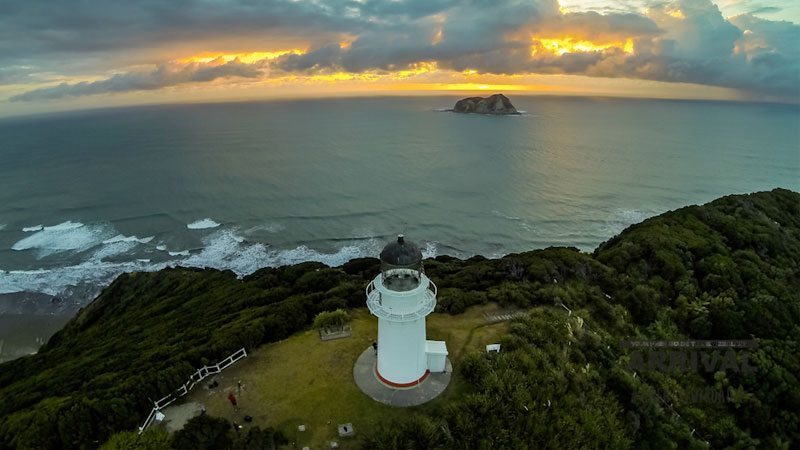The East Cape offers a slow, peaceful existence to those who reside there, and an equally relaxed, enchanting place for its visitors. With few harbours and a mountainous, wild bush interior, the Cape has been isolated for many years until the road network was completed. And still today, given the remote proximity of the region, few people take the opportunity to explore what seems to be one of New Zealand’s last frontiers. Inhabited predominantly by Maori, Gisborne and the Cape region place great emphasis on the retention of their culture and traditions – it is here you will hear Te Reo Maori (the Maori language) being spoken fluently and freely.
The coastal road is windy ‘tour of discovery’ providing spectacular views of a wild coastline interspersed with picturesque little bays, inlets and coves. Dozens of clear freshwater streams flow through stunning gorges from the mountains and in the summer months are greeted at the shoreline by the bright crimson blooms of the pohutakawa trees. Popular for fishing, diving and boating this must surely be one of the county’s best-kept secrets! Beautiful beaches contrast dramatically with rugged cliffs and rocky outcrops providing the perfect home to what seems to be an abundance of crayfish!
Surfing is popular on the beaches north of Gisborne, and the state forest parks of Ruatoria, Raukumara, Urutawa and Waioeka offer numerous walking tracks. The tracks afford wonderful views, a highlight for some being an overnight stay on Mt Hikurangi to see the first light of the new day – another spot made famous at the time of the new millennium. Some areas of the parks are even penetrable on mountain bike – but be warned, many parts are not! White water rafting is available on the Waioeke and Motu Rivers providing yet another thrilling finale to a relaxing sector of your holiday!
Between Gisborne and Rotorua, the Urewera National Park protects part of the largest native forest area in the North Island. Most visitors walk the Waikaremoana Track, (sea of rippling waters), one of New Zealand’s Great Walks around an amazing lake of the same name. Birds, trout, deer and other wildlife are plentiful in the park – take time to observe them by boat or on the walks, which vary from half an hour to several days. The main track is rated easy with five huts conveniently spaced along the route – but at peak times it is wise to carry a tent! Kayaking is also available, even a tramp-paddle option allows a little variety and a different perspective on the Lake and it’s glorious surrounds.
The Gisborne region has been settled for over 1000 years, although Europeans did not arrive until late in the 19th century when the first whaling station was established in the area. It was in Gisborne, however, that Captain Cook made his first landfall on New Zealand soil in 1769, naming it Poverty Bay after deciding it had nothing to offer! A monument to Cook can be found at the foot of Kaiti Hill, near the spot he first set foot, and a statue of ‘Young Nick’ sits at the river mouth. Nicolas Young, Cook’s cabin boy, was the first member of the crew to sight land – Cook named the white cliffs across the bay ‘Young Nick’s Head’.
As whaling increased, the missionaries followed and gradually more pakeha arrived. Continual Maori resistance inhibited the establishment of an organised settlement and many battles took place. Even today much of the pastureland is leased from the Maori, the fertile alluvial plains supporting intensive farming of sub-tropical fruits, market-garden produce and vineyards.
Famous for it’s Chardonnay, Gisborne is a major wine-producing region. Tours are available taking in the larger wineries, and some of the smaller companies also welcome visitors. The Gisborne Museum houses displays relating to east coast Maori and colonial history, as well as geology and natural history exhibits. One of the country’s largest Maori meeting houses, Te Poho-o-Rawiri, has a richly decorated interior and is located at the base of Titirangi (Kaiti Hill). This hill is also home to ‘The World’s Easternmost Observatory’, the Cook Observatory. The superb beaches offer good swimming, fishing and surfing and attract a wealth of bird life including stilts, oyster catchers and other sea birds. The visitor information centre has details on walks, horse trekking, fishing and hunting tours and other activities in the area – there is certainly no shortage of things to do!
To most Kiwi’s the East Cape is the ‘back and beyond’ and few take the time to really appreciate the treasures it most certainly possesses. In addition to the obvious scenic beauty of the area, its most famous jewel is that of Dame Kiri Te Kanawa, the world-renowned opera diva. It is hard to imagine that such a talented beauty was raised in such a remote place, how she managed to nurture her talent and be discovered! Dame Kiri has graced stages all over the world and also sang at the Royal Wedding of Charles and Diana in 1981.
Accommodation in Gisborne varies from camping grounds, to backpackers, guesthouses to motels and hotels. Along the coast it is a pleasure to simply turn up and see what’s available! Camping grounds with cabins and caravans are common, and motels, backpackers and quaint hostels are available in many of the small towns dotting the coastline. The beauty of the East Cape is that of discovery, not luxury. So take in everything it has to offer as there are few places left on earth that still offer life’s simple pleasures!


Leave A Comment